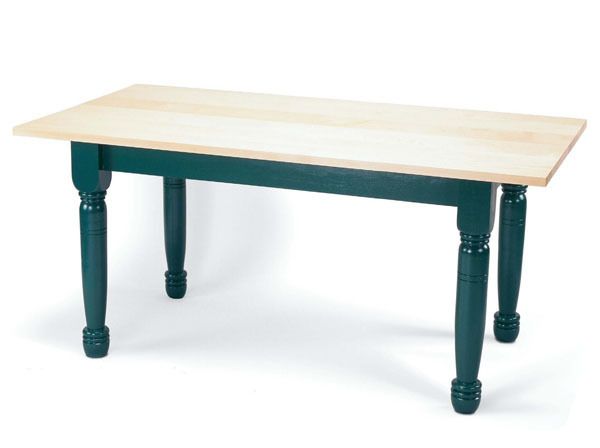My Kitchen Table
A knockdown design for a man on the move
Synopsis: Tim Gilchrist wanted a rugged, yet stylish kitchen table that was strong, sturdy, and portable. He suggests letting your lumber supplier do some of the work by surfacing your stock. He designed a wooden corner gusset, held in with hanger bolts, that he mortised and tenoned into the apron. He explains exactly how all the mortises and tenons need to be cut. Then he offers advice on turning the legs and making a tabletop that will withstand abuse.
I built my first kitchen table a number of years ago when I was still in college. My intent was to create a stylish yet indestructible platform capable of withstanding all potential abuse. I also wanted a piece of furniture that I could take apart and move at the end of the school year. That solid red oak structure bears its battle scars well. The table could support seven full kegs of beer at once, withstand the deeds of careless roommates and then be taken apart and moved with ease.
Now that I have a real job, a house and drink beer out of bottles, I decided to build a new table. I wanted something more stylish but with the same stalwart presence and convenient mobility of my trusty red oak table. I spent some time in furniture stores looking at tables for design inspiration before I found a style I was happy with.
Let your lumber supplier do some of the work
I work in a really small basement space. The dominant feature of the workspace is a large cast-iron oil burner, so I don’t have room for a lot of equipment. I do all my work on a Shopsmith combination tablesaw, bandsaw, lathe and drill press. Because I don’t own a jointer or a planer, I buy most of my lumber already surfaced. It costs a little more, but I don’t have any other choice, short of dressing it all by hand.
For this table, I chose 5/4 maple for the top and the apron, dressed to a full 1 in. thickness. For the turned legs, I got a good deal on some 8/4 Eastern white pine, clear as a winter’s day. So I had it dressed to a finished 11⁄4 in. thickness and laminated each leg from three thicknesses for a full 33⁄4 in. dimension. I’d never turned pine before. With this job, I learned that you have to keep your turning tools extra sharp to cut the pine cleanly.
Knockdown joints
My job may require me to relocate from one coast to the other, so I wanted to be able to take this table apart easily for the move. I’ve seen the stamped metal corner braces held in with wing nuts on hanger bolts on a lot of mass-produced furniture, but they looked too flimsy for my taste. So I designed a wooden corner gusset that would do the same thing. The ends of all four gussets and all four apron pieces were cut into tenons. The gussets fit into mortises cut into the inside of the apron pieces. The apron tenons slip into regular blind mortises cut into the legs.
From Fine Woodworking #123
For the full article, download the PDF below:
Fine Woodworking Recommended Products

Compass

Dividers























Log in or create an account to post a comment.
Sign up Log in